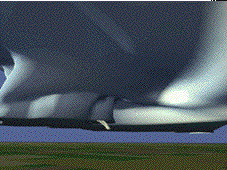
How Tornadoes are Formed
At this point in time, formation of tornadoes
are not fully understood by scientists. They usually form in a giant rotating thunderstorm
called a supercell. Supercells form when cold polar air meets warm tropical air. The
result is a great instability caused by the rising warm air. A squall line, or narrow zone
of cumulonimbus clouds forms, giving life to the tornadoes. Lightning flashes, and heavy
rains and hail begin to fall. Soon after, the easiest recognizable part of the tornado,
the funnel, seems to descend from the base of the cloud. In actuality, it does not, but
rather the pressure within the cloud drops due to the increasing wind speeds. This is
known as Bernoulli's principle. As the pressure drops, it causes moisture in the air to
condense. This action continues down the spiral, giving the impression that the funnel is
descending from the cloud base. In addition to the visible funnel, there is also a hissing
sound, which turns into a loud roar when the tornado touches the earth.
Many people believe that there is no tornado unless there is a visible
funnel cloud. However this is not true, for 'invisible' tornadoes can exist. Its the same
thing as a normal tornado, but the funnel cloud does not descend to the ground. The latter
situation is extremely rare.
Once the tornado reaches the ground, it starts to up debris around it. This can actually change the color of the tornado, because some dirt in the southern states is actually a deep shade of red. This is a simulation of how a tornado forms:
